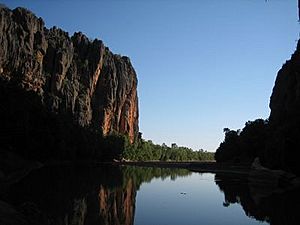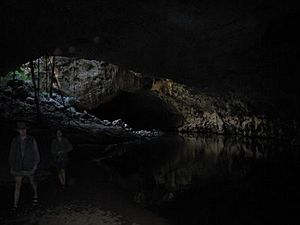Jandamarra facts for kids
Quick facts for kids
Jandamarra
|
|
|---|---|
| Born | c. 1873 |
| Died | April 1, 1897 Tunnel Creek, Western Australia |
| Place of burial |
Napier Range
|
| Allegiance | Bunuba |
| Years of service | 1894-1897 |
| Battles/wars | Australian frontier wars |
Jandamarra (born around 1873, died April 1, 1897) was an Aboriginal Australian man. His people were the Bunuba. European settlers called him Pigeon. Jandamarra became a famous leader who fought against the European settlers taking over Australia.
He first worked as a tracker for the police. But he became a fugitive when he had to capture his own people. Jandamarra then led a three-year fight against the police and settlers. He became known for his clever hit-and-run attacks. He was also famous for his amazing ability to hide and disappear.
Jandamarra was eventually killed by another tracker at Tunnel Creek. This happened on April 1, 1897. His family buried his body at the Napier Range. They placed it inside a boab tree. Jandamarra's life story has been told in books, a play, and a TV series.
Contents
Jandamarra's Early Life
The Bunuba people lived in the southern part of the Kimberley region. This is in the far north of Western Australia. Their land stretched from Fitzroy Crossing to the Wunaamin Miliwundi Ranges. It included the Napier and Oscar Ranges.
From a young age, Jandamarra learned many skills. He learned to ride horses, speak English, shear sheep, and use guns. He worked on William Lukin's station at Lennard River. People thought he was the best Aboriginal stockman there. Lukin called him "Pigeon" because he was small and fast.
When he was a teenager, Jandamarra went through a special ceremony. This was part of the Bunuba law. At 15, he returned to his homeland to learn traditional hunting. In 1889, police captured him and a man named Ellemarra. They were chained together and made to walk to Derby. They were accused of killing sheep. Jandamarra gained his freedom by agreeing to look after the police horses. He became well-liked.
About a year later, he went back to Lennard River to work. Then he returned to his traditional land. It was said he broke a Bunuba law there. So he moved to Lillimooloora station to avoid punishment.
In 1894, Jandamarra's friend, Bill Richardson, joined the police. Richardson was an English stockman. Jandamarra then became his native tracker. They worked at the police outpost in an old homestead. It was unusual for the time, but Richardson treated Jandamarra as an equal. They became known as a very effective police team.
The Fight for Freedom
Aboriginal people were spearing the settlers' livestock. This was a way to resist the settlers. Jandamarra was ordered to find and capture a group of Bunuba men. These men were at Lillimooloora Station. Among them was his uncle, Ellemarra.
His uncle and the other men reminded Jandamarra of his duties to his people. They also told him about a new policeman who had been killing Aboriginal people. They spoke of more European settlers moving onto their land. Jandamarra then made a difficult choice. He shot and killed Richardson while he was sleeping.
On November 10, 1894, Jandamarra and his followers formed an armed group. They attacked five white men who were moving cattle. These men were setting up a large station on Bunuba land. Two of the settlers were killed. Jandamarra's group took their guns and ammunition.
On November 16, 1894, police faced Jandamarra's group of 50 warriors. This was an eight-hour fight at Windjana Gorge. This gorge is a sacred place for the Bunuba people. Ellemarra died in the fight. But Jandamarra escaped, even though he was hurt. Because of this, Western Australia's first Premier, John Forrest, ordered the rebellion to be stopped. Police attacked Aboriginal camps. They killed some Aboriginal people just because they thought they might be connected to Jandamarra.
Guerrilla War Tactics
For the next three years, Jandamarra led a guerrilla war. He fought against the police and European settlers. His hit-and-run attacks became famous. His ability to disappear also became almost a legend. In one well-known event, a police patrol followed him. They tracked him to his hideout at Tunnel Creek in the Napier Range. But Jandamarra mysteriously vanished. He used the system of tunnels inside the mountains to escape.
Other Aboriginal people looked up to Jandamarra. They believed he could not be killed. They thought his body was just a form of a spirit living in a waterhole near Tunnel Creek. It was believed that only an Aboriginal person with similar special powers could defeat him. Police chasing Jandamarra were also amazed. He could cross the rough mountains barefoot. Their own boots were torn apart by the sharp rocks. Over the next few years, Jandamarra's group raided police and settler homes.
Micki, also known as Minko Mick, was an amazing Aboriginal tracker. He was also thought to have special powers. Micki was not from the Bunuba tribe. So he did not fear Jandamarra. He tracked Jandamarra down and shot him at Tunnel Creek. This happened on April 1, 1897. Jandamarra's body was buried by his family. It was placed inside a boab tree at the Napier Range.
Jandamarra's Legacy
Jandamarra's life story has been told in many ways. Two novels are about him: Ion Idriess's Outlaws of the Leopold (1952) and Mudrooroo's Long Live Sandawarra (1972). Mudrooroo wrote his novel for Indigenous readers. He wanted to show them a hero from their own culture.
Howard Pedersen wrote a history book about Jandamarra. It was called Jandamarra and the Bunuba Resistance (1995). This book won an award in 1996.
A stage play called Jandamarra was created in 2008. It was produced by the Black Swan Theatre Company. Jandamarra's story is also told in episode 5 of the 2008 TV series First Australians.
Australian singer Paul Kelly wrote a song about him. It's called "Jandamarra/Pigeon." It was released on his album The A – Z Recordings (2010). In 2010, Neil Higgins also wrote a song called "Jandamarra's War." It talks about the hard times the Bunuba people faced.
A documentary about his life was made in 2011. It was called Jandamarra's War. The Australian Broadcasting Corporation helped make it.
In 2014, a special musical work was created. It was called Jandamarra - Sing for the Country; Ngalanyba Muwayi.u. It was a cantata (a type of musical story). It was based on the stage play. It was performed at the Sydney Opera House. The Sydney Symphony Orchestra and other groups performed it.
The old Lillimulura Police Station is important to history. It is connected to Jandamarra's story. Its ruins are a few kilometers south of Windjana Gorge. Both Windjana Gorge and Tunnel Creek are popular places for tourists to visit today.
See also
 In Spanish: Jandamarra para niños
In Spanish: Jandamarra para niños



